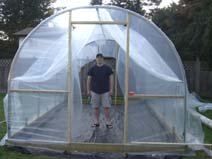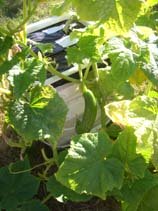|
Food4Wealth Review
Food4Wealth ReviewThis is one of those e-books that I was thankful that I purchased; however, I will still try to give you an un-biased Food4wealth review of Jonathan White's organic growing system. I liked the fact that Jonathan White, the author, has over 20 years of experience as an environmental scientist and horticulturist. I also appreciated the fact that he practices his methods in his own backyard, and offers pictures and informative video to prove it. See the Food4Wealth Homepage here.Food4Wealth reviewI had come across this e-book a number of times while researching other topics on the Internetand it was the title that threw me off a bit. Food4Wealth.... I thought that it was another get rich quickskeem that would promoting growing vegetables for sale out of your backyard. When I actually took the time to have a closer look, I found that Jonathan was claiming, throughthe title of his system, that if you followed his method you could save a potential $5,000 per year off ofyour families grocery bill. That, including a constant flow of free food from your own backyard, I came to agree, was well represented as Food4Wealth. The System:I keep referring to Food4Wealth as a system because of the way that it is packaged. It comes as an 80 page e-book, that can be instantly downloaded. What impressed me was the extensive videos (approx. 60 minutes worth) that are included on a number of subjects that he teaches. Being an audio/visual learner myself I appreciated the thought in which this was offered. Not only did you have the written book, that could be printed and referred to, the video was a nice touch. A list of the Videos that are included in the system:
Here is the System's Claim:It is a very common sense approach that is totally simple. It goes against all of the conventional ways that we are taught about Organic Vegetable Gardening. Jonathan is the first to point out that there are probably many within the profession that would reject this system,because it is unorthodox when compared to the traditional methods of vegetable gardening. This seems to be the way that Mother Natureintended it. See the Food4Wealth Homepage here.Food4Wealth reviewThe garden plot is built from the soil up, in a way that conserves water, protects itself from invasive insectsand diseases, and will not allow unwanted weeds to take root. The garden system is prepared in a way that itcan take care of itself. A Rain Forest grows without anyone having to plant seeds and weed, use fertilizers etc, etc.... Food4Wealth Review I like his use of a Rain forest as an example. There is a huge diversity of plants in a Rain forest scattered alongthe forest floor. The plantings are so dense that there is very little opportunity for anything else to take root. It is this idea of dense plantings in your garden that will keep the weeds from taking root, there is not any open soil, orwhat Jonathan refers to as Niche spaces, for them to grow. Scattered plantings, lettuce next to cucumbers etc..., help to eliminate the pressure from insects and disease from being too much of a problem. They are deterred in having to find theplants that they are looking for in this Jungle of Vegetable plants. This made me think of the traditional way of gardening tobe like an all you can eat buffet for the Insect world, a one stop shop so to speak. Also, the number of vegetablesthat can be grown in a relatively small allotment is increased greatly. See the Food4Wealth Homepage here.Food4Wealth reviewThe System Not only keeps weeds away it seeds itself:Once the system is established, and because of the scattered plantings, seeds will be distributed throughout your gardenover time. The garden bed, just like a rain forest, has so many seeds scattered it also deters weed seeds from taking root. When another plant offers the opportunity for one of these seeds to grow it does. Just as in nature, there is alwaysa seed waiting to grow, and in this garden it is usually a vegetable seed of some sort. The soil conserves and retains water, first off by the way that it is built up by using a few different layers of materialsas listed below, and secondly, because Jonathan White promotes that the soil is disturbed as little as possible. Prettymuch just by a scratch once and a while using your finger to see how moist it is under the surface. The rest of the timethere is relatively no digging, other than when planting a seedling. And when a plant is pulled he recommends that the hole is filled right away with some fresh compost, other wise that is it. See the Food4Wealth Homepage here.Food4Wealth reviewThere is no need for tilling, or crop rotation. Because of the way the garden is planted, and the soil is built up there is no need. And if you follow the system to a T, then you will be filling the wholes with fresh compost that you make from your own kitchen scrapsand yard waste. The system recommends that you add waste from your vegetable garden as well. This unconventionally includes the seeds fromspent vegetables. With these seeds being mixed into the compost there are always seeds being evenly distributed throughoutthe garden, the one that is ready will come through when there is an opportunity. And there is another way that the garden isable to seed itself. And eventually you will save yourself money on seeds. Here is how the soil is built up from scratch right over top of your existing lawn, all enclosed in a garden border usinga wood frame or rocks:
Just build it from scratch, or Jonathan even explains on how to turn an existing garden plot into a Food4Wealth plot, andmaintain it, by continually adding compost. There are claims that the system can be maintained with only 8 hours of light duty work per year. Large claim by I'm sold that this is true and that he is onto something here. Some of the suggested Vegetables:Although the system can be used to grow any vegetable, the following are some of the suggested to get started with your own system. The method and soil build up is even suggested to be used in growing vegetables in containers.
See the Food4Wealth Homepage here.Food4Wealth reviewHere is what I thought:I loved Jonathan's passion. He is truly, in my opinion, trying to make a large scale movement with his system. Onethat he believes can benefit people around the world, and you can tell it in the videos. Some would say that he laysit on a little thick, or there is some cheese, but I would argue that it is passion. Like I said I appreciated the common approach and the thought that video was added to the total package and not as anadd on sale. There are no added surprises here, just added value. Including the promise of access to all updated videosand information at no extra charge. This system, and it's concepts, are perfect for the novice or experienced gardener alike, and both ends of the spectrum wouldhave something of interest to find in this e-book. If you are growing on patios or in containers this is discussed in the book as well. I enjoyed the added bonus of a Fruit Food 4 wealth plot as well. Things that I questioned:In the system there was no mention that pressure treated lumber is treated chemically and should be used in your vegetablegarden at your own disgreation. Potatoes are part of the system but there is no explanation as to why they are segregated. After giving it some thought Ifelt that they may be too over powering to be let loose on their own in the scattered garden, they may over power other plantsfor the empty "Niche" spaces. Since Jonathan is from Australia, and I am from North America, I found that there was a bit of a diffence in the language used.For instance I had to google Lucerne Hay to find that it is more commonly refered to as Alfalfa Hay here. All in All 2 big Thumbs up. Am I using it:You bet. I am currently turning my Hoop House into a Food4Wealth plot. I feel that Jonathan's system is the perfect systemfor greenhouse growing. There is no need for crop rotation and you can produce a lot more produce from a lot smaller sectionof space. Compost and Gardening System: Food 4 Wealth - ReviewInclude Jonathan's 4 season system with a tool that lengthens those seasons, like a Hoop House, and you can produce even more vegetables. Ienvision even more than the suggested $5000 in savings :). I'll keep you posted. Guarantee:I am also very confident in recommending this book to all because it does come with a 60 day money back guarantee. You don't like it, get your money back. |
Please Help Us Get Social:
Valued Links and Featured Sites:
Greenhouse Plans
Free Greenhouse Gardening Construction Plans
"Ole Dirt Farmer"

Self Watering Container Plans
Don't want to make your own. There is also information about Earthboxes too.
These are great, either or.
Free Self Watering Container Plans
Jonathan White: Food 4 Wealth
It is a great fit. Be sure to take a look. Jonathan is a passionate guy. See below for our full review.
Aquaponic Plans
Links on this page will take you to Travis's free e-book.
A Malispina college student shares a video of her completed Barrelponic project. Complete with Tilapia.
Free Aquaponics (Fish and Vegetables) Plans











